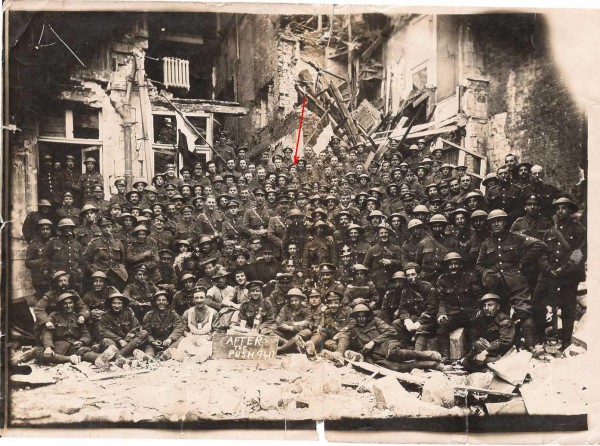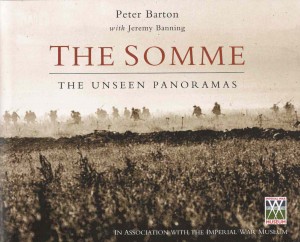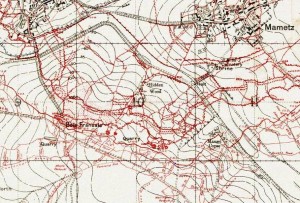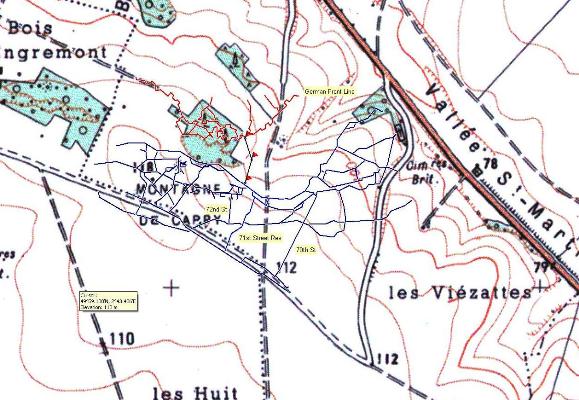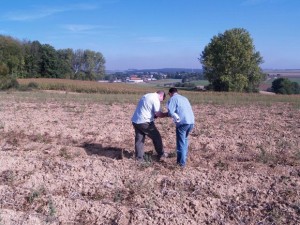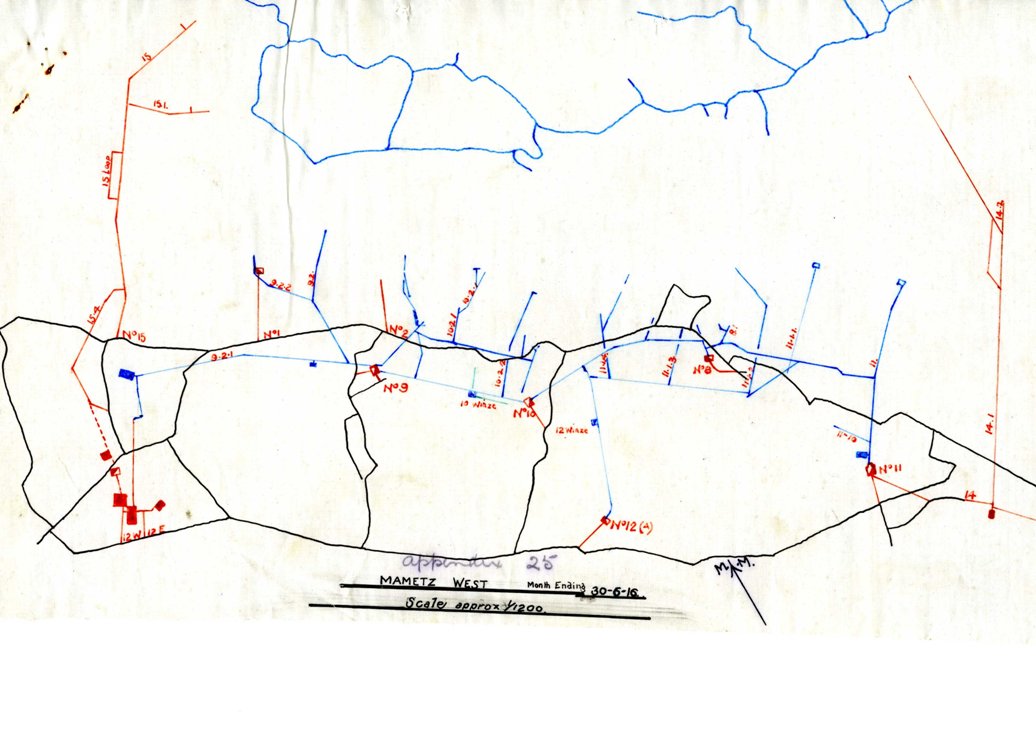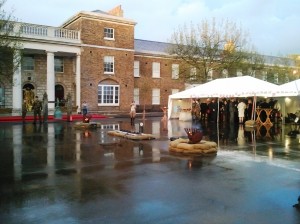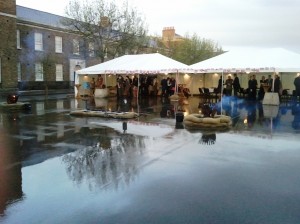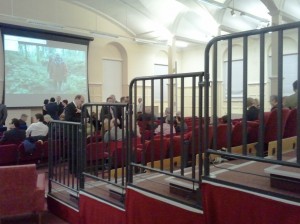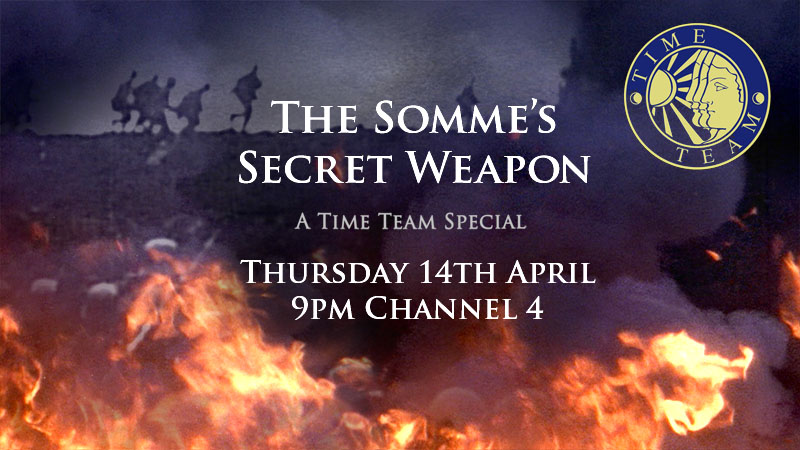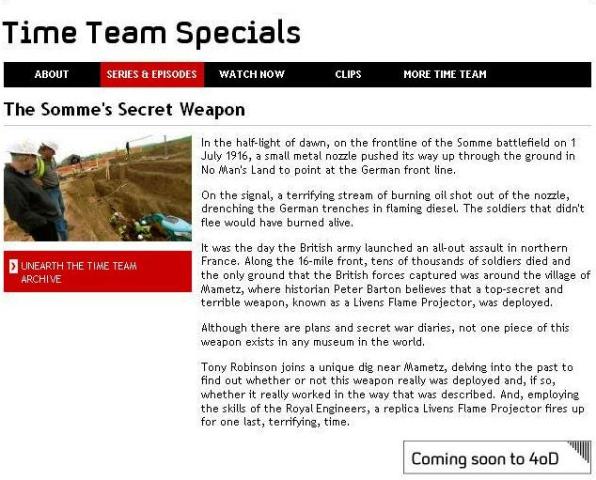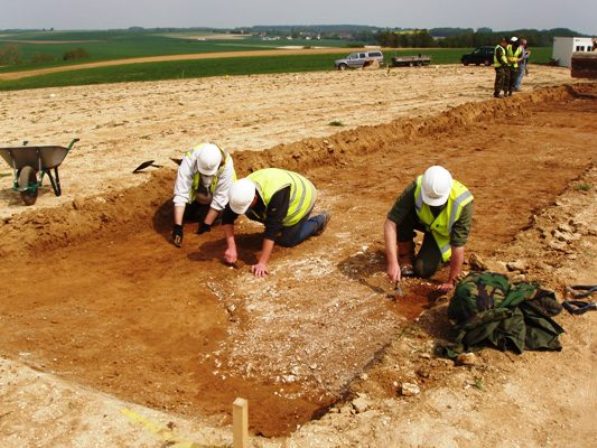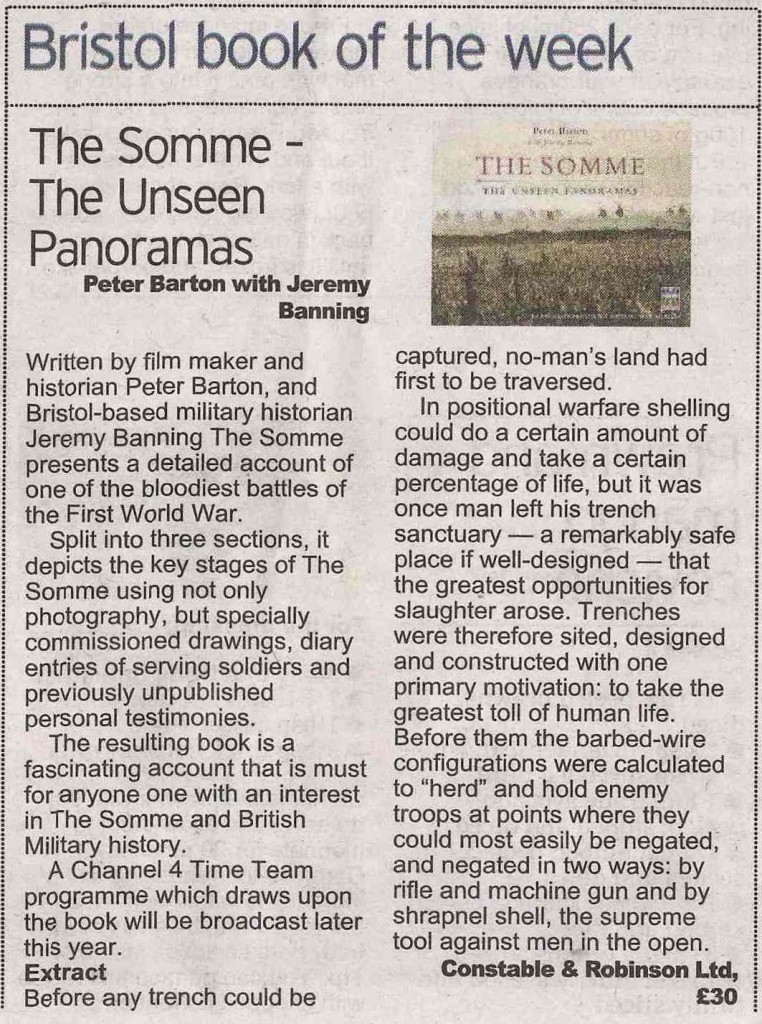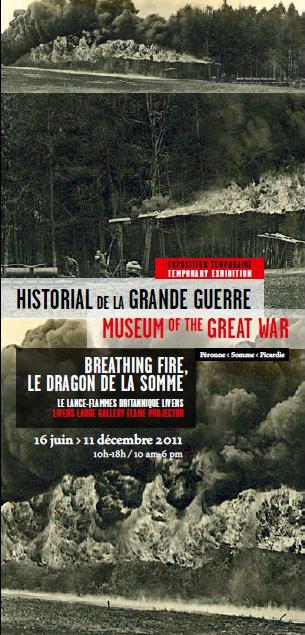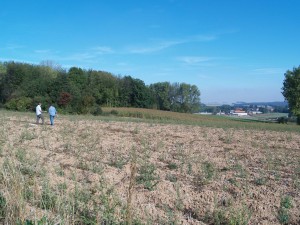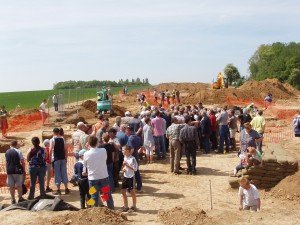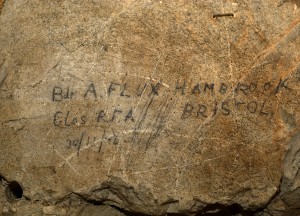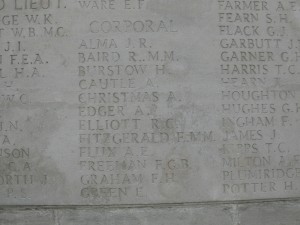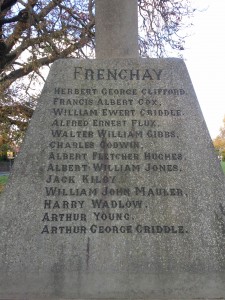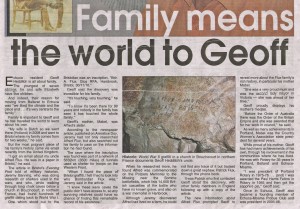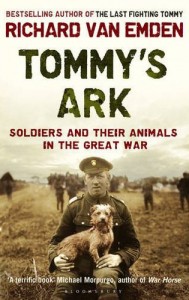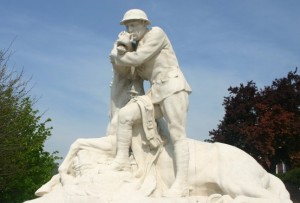Archive for the ‘Research’ Category
The Battle of Arras: April-May 1917 – my recent talk at Thames Valley WFA
I spoke at the Thames Valley Branch of the Western Front Association (WFA) last Thursday (28 April). When first approached I had to choose between speaking about the Livens Large Gallery Flame Projector on the Somme or the subject of our last book, The Battle of Arras. I opted for the latter, mainly because I figured that the Channel 4 Time Team programme would have been only shown a short time before and so many of those attending would know at least the gist of the story. So, Arras it was. The talk was to last for about an hour (as it was, I think I spoke for nearer 70 minutes) and so this necessitated a good deal of reading to refresh the memory. I prepared a PowerPoint presentation to illustrate some aspects of the talk and managed to get panoramas to slowly scroll across the screen too (a technical feat I was quite pleased with!)
The talk was entitled “The Battle of Arras: April – May 1917? and was well attended with about 45 people regulars plus my brother Mark Banning and his friend and regular battlefield companion Malcolm Sime.
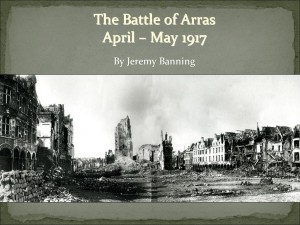 It was structured to not merely cover the battle but start with warfare in the Arras area in October 1914, look at the costly French actions of 1915 and then move on to British occupation in March 1916. The German attack against the 47th (London) Division on Vimy Ridge was touched upon and then I covered a basic backdrop to battle from the political and military standpoint and explained in detail the new German policy of ‘elastic defence’ to be brought into play for 1917. Moving through the Chantilly and Calais conferences I then spent some time on the German retreat to the Hindenburg Line (Operation Alberich) before exploring preparations for battle such as the tremendous work of the Royal Engineers. I also looked into French preparations, the actions of General Robert Nivelle and the extraordinary series of leaks and security lapses that marred the French pre-battle period. By this time half an hour had gone but I felt it important to set the scene fully and not merely delve straight into the battle itself.
It was structured to not merely cover the battle but start with warfare in the Arras area in October 1914, look at the costly French actions of 1915 and then move on to British occupation in March 1916. The German attack against the 47th (London) Division on Vimy Ridge was touched upon and then I covered a basic backdrop to battle from the political and military standpoint and explained in detail the new German policy of ‘elastic defence’ to be brought into play for 1917. Moving through the Chantilly and Calais conferences I then spent some time on the German retreat to the Hindenburg Line (Operation Alberich) before exploring preparations for battle such as the tremendous work of the Royal Engineers. I also looked into French preparations, the actions of General Robert Nivelle and the extraordinary series of leaks and security lapses that marred the French pre-battle period. By this time half an hour had gone but I felt it important to set the scene fully and not merely delve straight into the battle itself.
I structured the actual battle part of the talk by focussing on the First and Third Army fronts from north to south, starting with the Canadian Corps attack on Vimy Ridge before moving into what I always think of the main ‘Arras proper’ battlefield. Realising that no talk about the Battle of the Somme would neglect to work its way down the front line for 1 July 1916 I adopted the same structure – following each division’s success (or failure) as we moved southwards across the Scarpe and Arras-Cambrai road into Hindenburg Line territory until ending with the 21st Division at the south of the attacking frontage. Explaining the reasons for success in many sectors and failure in others I then worked my way through the battle focussing on stand-out actions. These included the capture of Monchy-le-Preux on 11 April 1917 and the destruction of the cavalry of the Essex Yeomanry and 10th Hussars in the village.
I also covered the attack by two battalions of the 10th Brigade (4th Division) towards the village of Roeux and the Chemical Works. 1/Royal Irish Fusiliers and 2/Seaforth Highlanders suffered grievous losses in the attack; the Seaforths attacked with 12 officers & 420 Other Ranks and their losses were all 12 officers & 363 O.R. This meant that a mere 57 men survived the action unwounded – and the objective wasn’t gained in any way. The beautiful Seaforths Cross on the Sunken Lane at Fampoux is a reminder of the men who attacked and suffered so much that day. I touched on the fighting at Bullecourt that day but felt that the disastrous actions around that particular salient village warranted a talk of their own.
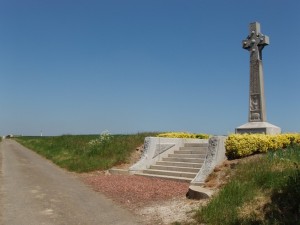 The next attack to be looked into was the attack up Infantry Hill by the Newfoundland Regiment and 1/Essex Regiment on 14 April 1917 – an attack that almost destroyed both battalions and which left the way open for the German reoccupation of Monchy. The day was saved by a gallant band of men led by Lt Col James Forbes Robertson, CO of the Newfoundlanders who organised a small group of men to run to eastern buy discount ambien edge of village and open rifle fire. For five hours their fire held the Germans at bay until the village was relieved. All were decorated and became known as ‘The Men Who Saved Monchy’.
The next attack to be looked into was the attack up Infantry Hill by the Newfoundland Regiment and 1/Essex Regiment on 14 April 1917 – an attack that almost destroyed both battalions and which left the way open for the German reoccupation of Monchy. The day was saved by a gallant band of men led by Lt Col James Forbes Robertson, CO of the Newfoundlanders who organised a small group of men to run to eastern buy discount ambien edge of village and open rifle fire. For five hours their fire held the Germans at bay until the village was relieved. All were decorated and became known as ‘The Men Who Saved Monchy’.
I then worked through the month of April, looking at the failed French attacks on the Aisne and then explaining the movements of 23 April (Second Battle of the Scarpe) with particular emphasis on the fighting for Roeux and the Chemical Works by the 51st (Highland) Division. The battle was deteriorating against well organised and deployed German troops employing the new ‘elastic defence’ doctrine. It was a dreadful time – Third Army suffered 8,000 casualties alone on the 23rd/24th April.
It seemed apt giving the talk on 28 April as I then touched on the attack that day 94 years ago and the capture of the village of Arleux. It was building to the climax of battle – the Third Battle of the Scarpe on 3 May 1917 – a very dark day indeed for the British Army. The 21km frontage from Fresnoy in the north to Bullecourt (again) in the south lent itself to particular problems. The Australians at Bullecourt wanted a night attack to aid their chances of success – in the north this would have been disastrous for the attack on Oppy Wood. A miserable compromise was reached and Zero Hour was set for 3.45am – the attack was still to go in at night time. It was a terrible fiasco – many units were unable to even find their starting points and had no idea of direction to attack, merely following the direction of the artillery barrage with the hope of finding some Germans. Accounts mention morale being poor and a general malaise amongst the depleted attacking divisions. I read from the Official History: Military Operations France and Belgium 1917 by Cyril Falls as it summed up most eloquently the reasons for failure on 3 May 1917:
“The confusion caused by the darkness; the speed with which the German artillery opened fire; the manner in which it concentrated upon the British infantry, almost neglecting the artillery; the intensity of its fire, the heaviest that many an experienced soldier had ever witnessed, seemingly unchecked by British counter-battery fire and lasting almost without slackening for fifteen hours; the readiness with which the German infantry yielded to the first assault and the energy of its counter-attack; and, it must be added, the bewilderment of the British infantry on finding itself in the open and its inability to withstand any resolute counter-attack.”
I concluded with the finals stages of battle, the loss of Fresnoy and eventual capture of Roeux and the Chemical Works and for my last slide whilst talking about the men who had done the fighting I showed one of my favourite pictures. It shows a triumphant shot of a group of the 12/West Yorkshire Regiment in Arras celebrating their success of 9 April with captured booty. I was amazed when a man in the front put his hand up, saying he had spotted his grandfather in the photo! Apparently the only wartime souvenirs that his grandfather left were his medals and a copy of this photo. The man was 50496 Acting Corporal John Davison Johnson (marked with a red arrow in the photo) and I thank his grandson, John Johnson for this information – it quite made my night!
All feedback received has been good and the Branch Chairman, Bridgeen Fox, wrote very warmly afterwards with her thanks. Her comments can be read here. As she herself said, “it should have raised the profile of the battles of Arras and I hope it will have encouraged more people to explore the area”.
When I have some time I will write a blog piece with detail about the 3 May fighting. My thanks to Geoff Sullivan from the wonderful ‘Geoff’s Search Engine’ for furnishing me with some tremendous statistics for that day. If anyone is intersted in hearing this talk then please contact me. I am speaking on this subject in Bristol in October – see here for details. For those with an interest in the battle our panorama book on the subject is available here. Alternatively, if you are interested in a battlefield tour to Arras then please contact me – I would be happy to discuss.
Invite to the premiere screening of the ‘Breathing Fire’ documentary on the Livens Large Gallery Flame Projector
I was very pleased to receive my invitation to the premiere screening of the ‘Breathing Fire’ documentary on the Livens Large Gallery Flame Projector. This event, held by the Corps of Royal Engineers, will take place at the Brompton Barracks, Chatham on 11 April and will be held in aid of the Army Benevolent Fund. I know that a large number of us who were involved in the project are attending and it will be great to see the final edit on the big screen – the result of much work and dedication from a large number of people. Quite what version will be shown is unknown but I presume it is the longer buy placebo ambien version made for History Television.
I am very much looking forward to seeing Tony & Iain from the Centre for Battlefield Archaeology, Brian and his colleagues at Bactec, the expert EOD & landmine clearance company who did so much for us throughout the project and, of course, the sappers of the Royal Engineers we had the pleasure to work with.
A broadcast date for the UK market (this will be a Time Team Special on Channel 4) is still not known for definite. I will post this as soon as I have the necessary details.
Details of the upcoming museum exhibition at the Historial, Peronne can be found on this blog piece HERE.
Following the three week archaeological dig at Mametz last May I am pleased to report that a new exhibition is to open at the Historial, Peronne from 16 June 2011.
Below is the text from the flyer that has been produced. If you are on the Somme from June – December then please do visit the Historial for the chance to see this exhibition.
An exhibition that tells for the first time the story behind the Livens Large Gallery Flame Projector. Employed only ten times during the war – nine of which were on the Somme. The machine was 19 metres long, 40 centimetres wide, and weighed 2.5 tonnes. It was deployed from a tunnel beneath No Man’s Land by a specially-trained crew of seven, and fired a jet of flaming oil 100 metres long over the German trenches: the strangest, rarest and most horrifying weapon of the Great War.
In May 2010 historians and archaeologists excavated a section of the British trenches near the village of Mametz in search of the remains of a Flame Projector believed to have been buy cheap tramadol 100mg abandoned underground in late June 1916, just before the Battle of the Somme. The results were extraordinary, and for the first time for almost 100 years some of the original parts found in 2010 can be viewed alongside a specially-commissioned replica constructed by local students of vocational training centres.
A special screening of the film “Breathing Fire – Le Dragon de la Somme” will be shown at the opening of the exhibition, 16 June at 6pm.
 A downloadable version of this flyer in pdf is available by clicking on the link below. Please feel free to disemminate this information to all your friends and battlefield visitors. It promises to be a terrific exhibition and for many will be the first chance to see parts of the Livens Flame Projector, buried in the Somme mud for 94 years.
A downloadable version of this flyer in pdf is available by clicking on the link below. Please feel free to disemminate this information to all your friends and battlefield visitors. It promises to be a terrific exhibition and for many will be the first chance to see parts of the Livens Flame Projector, buried in the Somme mud for 94 years.
Breathing Fire – Le Dragon de la Somme exhibition
Exact date of transmission of the version for UK television still to be determined. I will post this when I find out the date from the production company.
I use the tools supplied by WordPress and Google Analytics to follow how visitors reach my site. I am seeing a large number of visitors searching for details on the archaeological dig and accompanying television documentary programme that followed our search for any surviving pieces of a Livens Large Gallery Flame Projector at Mametz in May 2010. As the site was open to visitors and there was no ban on photos I don’t think it is breaking any great secret to reveal that we DID find pieces of this amazing weapon. It was 19 metres long, 40 centimetres wide and weighed 2.5 tonnes. Its specialised team of seven ensured it fired three ten second bursts of flame for up to 100 metres and, perhaps most remarkably, this was fired from a tunnel or ‘Russian Sap’ dug specially under No Man’s Land.
At present (14 February) there is no broadcast date available for the UK or North American market. In the UK the programme will be broadcast as a Channel 4 Time to order tramadol Team Special. As soon as I know the broadcast date I will post the details so please check back or follow me on Twitter to be kept up to date.
In the meantime, a couple of pictures.
Update – 13 April 2011.
The Time Team Special will be shown on Channel 4 at 9pm on 14 April. A detailed description of the birth, evolution and structure of the project along with maps and images is now available here:
I have been researching certain members of this family after I spotted some graffiti of a Great War soldier, Bombardier Alfred Flux from Hambrook, whilst exploring caves under the church in Bouzincourt on the Somme in May last year. Whilst the caves were covered in graffiti from soldiers from all over the world I was intrigued by this local man and endeavoured to find out more about him.
Full details of this can be found on the newspaper link below as the story was featured in the Armistice Day editions of the Bristol Evening Post, Western Daily Press and Bath Chronicle.
Alfred Flux
832011 Corporal Alfred Ernest Flux, serving with “Y” 61st Trench Mortar Battery, Royal Field Artillery was killed on 21 March 1918, aged 25. He was the son of Alfred William and Emily Flux, of Walton Farm, Hambrook, Bristol and is commemorated on the Pozières Memorial to the Missing.
Alfred had served in 1916 in the Laventie area with involvement in the Battle of Fromelles on 19/20 July 1916 and stayed in this sector until his Division moved south to the Somme in mid-November 1916. The war diary says they were billeted in caves under Bouzincourt Church on 28 November and the graffiti is dated 30 November. The Battery stayed at Bouzincourt until January 1917 and then they went back for rest. February 1917 saw a move to Harbonnieres, south of the River Somme until May 1917. By June 1917 the battery was near Arras and then moved up to the Ypres sector where they were employed as stretcher bearers for the 38th (Welsh) Division in the Canal Bank sector on the first say of the Third Battle of Ypres (Passchendaele). They stayed in the salient until September when they moved back down to the Arras front, holding the dreaded Chemical Works and Greenland Hill sectors for the next two and half months. They then moved down to the Somme area and in January 1918 were ensconced in the Holnon Wood sector west of St Quentin. It was whilst holding these positions against the German Spring Offensive on 21 March 1918 that Alfred Flux was killed.
Since the article being released I have been in further touch with members of the Flux family, notably Judith Pike (who lives in Bristol) and Geoff Hedditch from Echuca, Victoria in Australia. I had done a fair bit of research into the family so knew that Alfred was one of a family of five children but Judith explained that Alfred’s younger brother, Francis Charles (but known as Charlie until his death at the ripe old age of 86 years) had also served as an artilleryman in the Great War. I volunteered to find out as much of his service as I could and was able to produce a detailed report for the family. Luckily, Charlie’s service record had survived and so I could piece together his service with 47 Brigade, RFA and then various Trench Mortar Batteries of the 19th Division. Other than suffering from dysentery in 1915 he appears to have been unwounded and was demobbed in February 1919.
I was both amazed and delighted by the huge amount of detail you have unearthed. Your information has opened up that era in a fascinating way I never expected to happen. I would like to say a big thank you for your diligence in researching my grandfather, and of course, initially finding out so much about his brother Alfred. Thank you for all you have done to bring real colour into our family history, and I want to wish you every success with your work as a researcher of the Great War. Judith Pike, Frenchay, Bristol
I was delighted to receive some post this morning from Geoff Hedditch in Australia. Enclosed in the envelope was a copy of his local newspaper, the Riverine Herald, which included an article about Geoff and his delight at the work I had done. I would like to thank Patrick, Judith and Geoff (all members of the Flux family) and Alan Freke and his fine colleagues at Frenchay Village Museum for their help. It just goes to show what a spark of interest coupled with a bit of determination can achieve – quite amazing that this story could travel all the way to Australia.
Please also remember the Flux boys themselves – Alfred and Charlie – who both answered their country’s call when needed and who, for one, paid the ultimate price.
Animals in the Great War – new book out
Whilst at the National Archives last week I met up with Richard van Emden for a coffee and he gave me a copy of his latest book, Tommy’s Ark: Soldiers and Their Animals in the Great War. I had been eagerly waiting for this as I had done a good deal of research for Richard on this book about a year ago and wanted to see how this fitted into the finished product as well as look at the reams of material that Richard had found. I was delighted with what he and Bloomsbury have produced. The jacket cover is in the same style as that used for Richard’s recent books with the same publishers, The Last Fighting Tommy and The Soldier’s War and shows a small dog, Sammy, the mascot of the 1/4th Northumberland Fusiliers who travelled out to France with the battalion in April 1915, served at Ypres (where he was wounded and gassed), was buried by shellfire on a number of occasions and later served on the Somme. Just this description gives some idea of the strange and amazing stories that the book contains.
The publishers blurb desribes it thus:
“This book tells the story of all the creatures, great and small, that inhabited the strip of murdered earth that snaked hundreds of miles from the Belgian coast to the Swiss Alps. In all, 61 species are included here and within a few species, such as birds and butterflies, there are also a number of varieties: for example, 43 kinds of bird are noted. Some species are mentioned once, others on a number of occasions: these include spiders, maggots, canaries, chickens, owls, lions, turkeys, fish, horses, cats, ferrets, wasps and worms. However, just as importantly, this is not a book about wildlife in isolation from man. On the contrary, it is about the human condition in war, explored through the soldiers’ relationship with the natural world around them…”
Michael Morpurgo, author of War Horse, writes: “If ever you are in doubt about the devastation and universal suffering that war brings to us, and to all creatures, great and small, then read Tommy’s Ark”
I really cannot wait to get stuck into it as soon as my current read is finished. When Richard and I were discussing how the book would work we identified various potential pitfalls to overcome; the main one being to avoid repetition. Having found many thousands of words of quotes myself I know the variation there is regarding these animals. Subsequent conversations and a good look through the book has confirmed my thoughts – there are such a wide range of stories that the reader really won’t be disappointed. My favourites (from the ones I found) are the old lady keeping bees on the lower slopes of Vimy Ridge in 1916 and the officer who tried to smuggle his beloved dog ‘Teddie’ buy xanax 0.25 back to Blighty at the end of hostilities. The images are terrific too – monkeys, dogs and kittens in the trenches as well as a collection of exotic mascots including a full grown bear!
I am sure it will sell well, particularly in the UK, as we have such an affinity to animals. Witness recent news items with the reactions to any instances of animal cruelty – I have seen people get more upset over the welfare of animals than people! Even on battlefield visits the wonderfully moving 58th (London) Division Memorial at Chipilly with its depiction of a soldier comforting his wounded horse has reduced some visitors to tears.
A quick word about conducting research for the book. Richard asked me to help him in finding animal stories in letters, memoirs and diaries. When I worked on the IWM panorama books Somme, Passchendaele and Arras with Peter Barton research was relatively easy, albeit time consuming. I visited over twenty different regimental museums around the UK as well as the Liddle Archive and many countless days in the Department of Documents at the IWM. My research was always tailored to a battle so I could use the archive search facility (if they had one!) for e.g. Somme or Arras. I also had a good knowledge of battalions, brigades and divisions which had served in each battle so could focus my reading that way. However, searching for stories involved animals presented many challenges. Only the most obvious stories were included in any précis of a collection – these were secured straight away. Subsequent research was on a more ‘hit and miss’ nature. The IWM holds so much material but, from my time spent there, I knew that certain memoirs were better written than others or that the writer had a particularly inquisitive mind and keen eye. It was these that I began with and, more often than not, I was rewarded with an animal story. On occasions though I recall a hard afternoons speed reading of hundreds of pages of memoir, letters or diaries and nothing to show for it other than a headache and blurry eyes. I shudder to think how many words we read in order for Richard to get the requisite 100,000 words but it was all interesting stuff – the hardest part was not getting waylaid on other interesting stories that one came across.
I am sure that Bloomsbury will soon be pulling out all stops to promote the book so they don’t need any PR from me. However, for those interested further details of the book along with a collection of interviews and ephemera from veterans can be found on Richard’s new website: http://www.richardvanemden.com/



